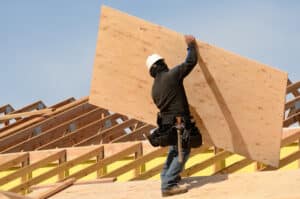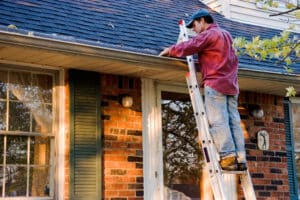If you’re considering replacing or repairing your roof, you’ve probably heard words like soffit, vapor barrier, decking, and fascia. These words can seem confusing at first, but understanding what they mean can help you navigate the complexities of roofing. Read on to review some of the most commonly used terminology in residential roofing, along with a few tips every homeowner should know.
Important Residential Roofing Terminology
You can make more informed decisions about your roof by understanding some of the terms used by professionals on the job. Take a few moments to familiarize yourself with the jargon used to define various parts of a roof. Some residential roofing terminology you’re likely to hear include:
Roof Deck: Also called sheathing, the roof deck supports the weight of the shingles above. Roofers build roof decks with large plyboards attached directly to the trusses.
Underlayment: The roof’s underlayment is a protective layer of material lying between the shingles and the roof deck. Synthetic or felt underlayment helps prevent moisture from seeping into the roof.
Penetrations: Examples of penetrations include a chimney or an exhaust vent from the attic. Penetration points are susceptible to roof leaks and sealed with some form of flashing.
Louvers: The air vents located along the top of a roof are also called louvers. These vents are available in many different styles ranging from the traditional turbine to more low-profile models.
Fascia: The portion of the roof directly behind a home’s gutter system is the fascia. These boards close any openings along your roof edge where moisture or pests could enter.
Valley: Intersection planes on a roof create valleys. Since rainwater flows more often down valleys, these areas require careful attention during installation.
Drip Edge: The roof’s drip edge is a piece of metal installed along the side of a roof where the shingles meet the fascia. This material helps to prevent water damage to the roof.
Roof Joists: The joists of a roof are the boards that support the deck and all the layers above. These boards are usually spaced between a foot and 24 inches apart.
Flashing: Most flashing is metal, rubber, or a durable synthetic material. Roofers seal joints and gaps in the roof where water can enter with sheets of flashing.
Soffit: The soffit is the part of the roof located along the underside of the roof’s eave. Soffits often contain vents which help to keep the attic space ventilated.
Downspout: The part of the gutter system leading directly to the ground is called the downspout. Some downspouts have extensions attached to the end to help carry water further away from the foundation.
Gable end: When two opposing roof planes meet, they form a triangular area called a gable end. Windows, vents, or other decorative elements are often placed in gable ends.
Ways to Prepare for a Roofing Project
If you’re planning on replacing your roof altogether, take some time to consider what type of roofing material you’d prefer. Different manufacturers offer shingles, shakes, and ceramic tiles with various unique design features. Consider the fire and wind rating of each option as well before deciding.
Make preparations for the project by making extra space around the outside of the home for roofers to maneuver. They may also need some space to stage materials, so creating a little extra room can help expedite the project. DIY roof work is dangerous and can be very time-consuming. Instead, find a local, trusted roofer to ensure the job gets done safely and efficiently.
Residential Roof Maintenance Tips
Keeping up with routine roof maintenance can extend the lifespan of your roof and potentially save you a lot of money. A comprehensive maintenance plan should include gutter cleaning, light repair work, and washing away any algae or moss growth on the roof. Speak with your roofer about conducting inspections twice a year as well, especially following severe weather events. Finding roof issues early on will stop them from spreading into bigger repair jobs in the future.
It’s a good idea to perform a visual inspection of the roof from the ground after a storm passes. High winds and heavy rain can throw debris onto the roof, damaging shingles or clogging gutters. Look for overflowing water from the gutter system or any roofing shingles strewn around the outside of the house.
When you need to repair or replace the roof of your southern New Hampshire or northern Massachusetts home, trust Adam Vaillancourt Roofing for superior service. Our dedicated team has years of experience helping homeowners with all their roofing needs. We offer flexible payment options and work closely with each of our clients through every stage of the roofing project. Call us to schedule an appointment today.




